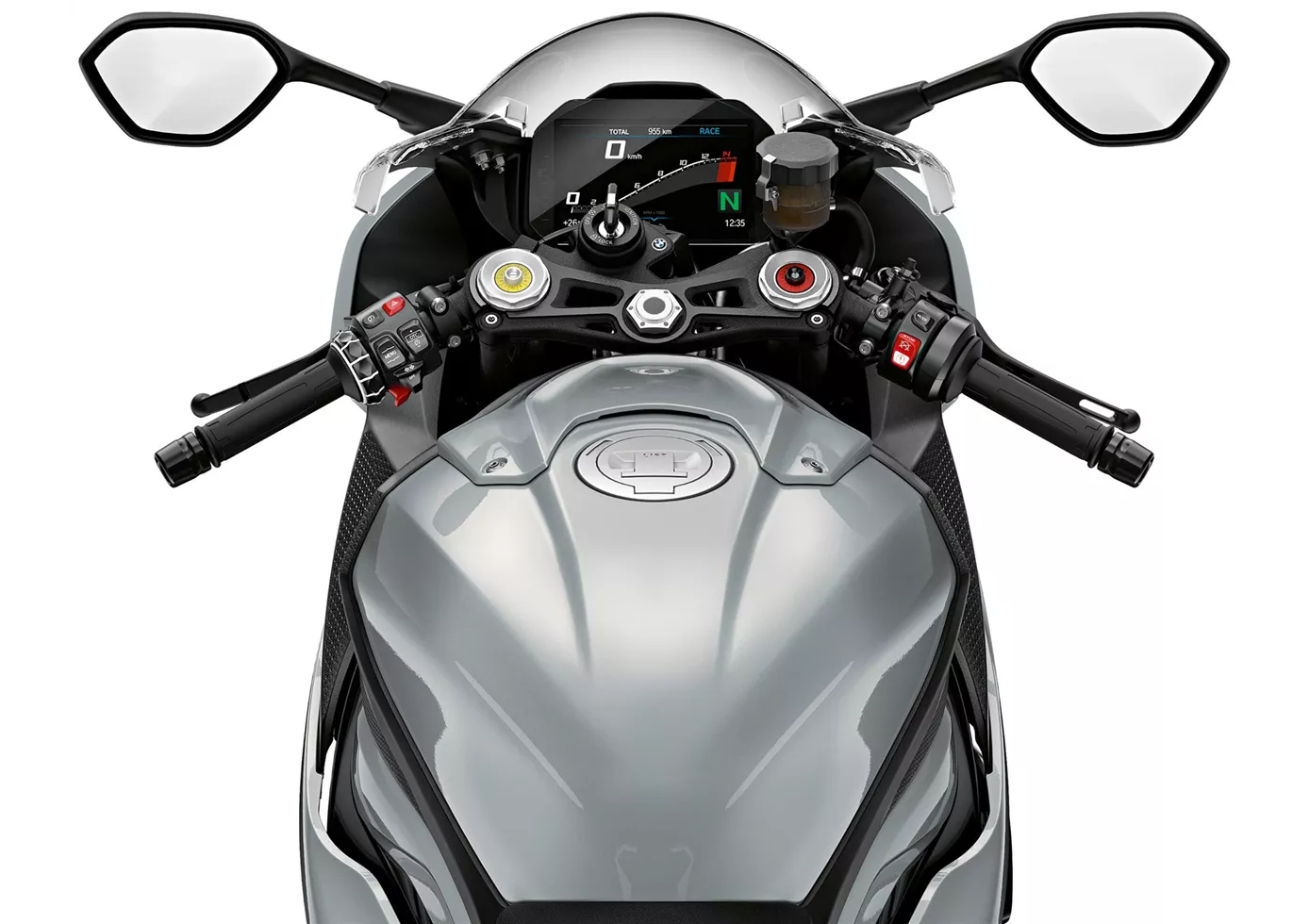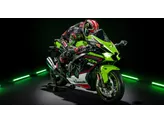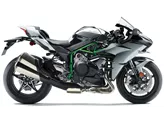BMW S 1000 RR 2020 vs. Kawasaki Ninja H2 2015

BMW S 1000 RR 2020

Kawasaki Ninja H2 2015
Visão geral - BMW S 1000 RR 2020 vs Kawasaki Ninja H2 2015
The BMW S 1000 RR 2020 and the Kawasaki Ninja H2 2015 are both powerful and high-performance supersport motorcycles. However, they have some differences in terms of technical specifications and strengths.
Starting with the BMW S 1000 RR 2020, it is equipped with an inline engine with a displacement of 999cc. It produces a power of 207 HP and a torque of 113 Nm. The engine has a high compression ratio of 13.3, which contributes to its performance. The bike features a four-cylinder DOHC engine with four valves per cylinder. It has a smooth power delivery and a wide range of RPMs, making it highly controllable. The BMW S 1000 RR also boasts a top-notch suspension system with adjustable compression, preload, and rebound settings for both the front and rear suspension. The chassis is made of aluminum, providing a lightweight yet sturdy frame. The bike has dual disc brakes with radial technology for excellent stopping power. It has a width of 120mm for the front tire and 190mm for the rear tire. The wheelbase is 1441mm, and the seat height is 824mm. The weight of the bike, including ABS, is 197kg, and it has a fuel tank capacity of 16.5 liters.

BMW S 1000 RR 2020
On the other hand, the Kawasaki Ninja H2 2015 is also equipped with an inline engine, but with a slightly smaller displacement of 998cc. It produces a power of 200 HP and a torque of 133.5 Nm. The engine has a lower compression ratio of 8.5. Similar to the BMW S 1000 RR, the Ninja H2 has a four-cylinder DOHC engine with four valves per cylinder. The bike features a telescopic front suspension and a single swingarm rear suspension, both with adjustable compression, preload, and rebound settings. The chassis is made of steel, providing stability and durability. The Ninja H2 has dual disc brakes with radial technology for strong braking performance. It has a width of 120mm for the front tire and 200mm for the rear tire. The wheelbase is slightly longer than the BMW S 1000 RR at 1455mm, and the seat height is 825mm. The weight of the bike, including ABS, is higher at 238kg, and it has a fuel tank capacity of 17 liters.
In terms of strengths, the BMW S 1000 RR 2020 offers a very linear power delivery, making it highly controllable. It has a wide range of RPMs and a pleasant handling experience. The bike also features an excellent Dynamic Damping Control (DDC) system, providing precise and top-performance suspension. It has a comprehensive electronic package, making it suitable for both road and track use. Overall, the BMW S 1000 RR offers a harmonious package with impressive performance.
On the other hand, the Kawasaki Ninja H2 2015 is praised for its excellent build quality and a fascinating engine with a mechanical supercharger. It offers exceptional traction, acceleration, and speed, taking performance to a whole new level. The bike provides a secure riding position, even for smaller riders, thanks to its narrow seat. It offers great stability and inspires confidence despite its high performance. The Ninja H2 also features strong brakes and high-quality details.

Kawasaki Ninja H2 2015
However, both bikes have their weaknesses. The BMW S 1000 RR 2020 may lack some character compared to its competitors, such as Aprilia and Honda. It also falls slightly behind in terms of specifications when directly compared to other bikes. On the other hand, the Kawasaki Ninja H2 2015 may have some issues with the response behavior during the transition from push mode to acceleration phase. It may also experience understeer in fast corners. Additionally, taller riders above 185cm may find it challenging to fit their feet into the overall aerodynamic concept of the bike.
In conclusion, the BMW S 1000 RR 2020 and the Kawasaki Ninja H2 2015 are both powerful and high-performance supersport motorcycles. The BMW S 1000 RR offers a linear power delivery, a wide range of RPMs, and excellent suspension, while the Kawasaki Ninja H2 provides exceptional acceleration, stability, and high-quality construction. Both bikes have their strengths and weaknesses, and the choice between them ultimately depends on the rider's preferences and priorities.
Especificações técnicas BMW S 1000 RR 2020 em comparação com Kawasaki Ninja H2 2015
Prós e contras em comparação
Prós e contras em comparação
BMW S 1000 RR 2020

Uma verdadeira superbike "polivalente". A BMW sabe como jogar com os seus pontos fortes tanto na pista de corrida como na estrada rural. Graças ao controlo variável da árvore de cames, o potente motor já convence na parte inferior e acelera harmoniosamente em toda a gama de rotações, com muita potência em todas as gamas. Para o piloto amador, o chassis funciona de forma excelente em todas as situações, proporciona um feedback transparente e oferece muitas opções de ajuste. A posição do assento é desportiva, mas relativamente confortável. A eletrónica funciona de forma muito harmoniosa, sem ser condescendente com o piloto - TOP!
Kawasaki Ninja H2 2015

A Ninja H2 representa um marco na história das motos. Não só está repleta de inovações electrónicas, como também oferece tecnologias completamente novas em termos de construção e mecânica do motor. Este objeto de investigação de alta tecnologia de uma empresa tecnológica japonesa está atualmente à venda e também pode ser conduzido. Basicamente, anda como uma mota normal, mas com muito mais potência. No início, a resposta do motor é um desafio, mas os fanáticos por velocidade encontrarão uma forma de conduzir e desfrutar desta fascinante mota.
Comparação de preços Preço médio de mercado BMW S 1000 RR vs Kawasaki Ninja H2
There are a few key differences between a BMW S 1000 RR 2020 and a Kawasaki Ninja H2 2015. In terms of price, the actual average price of a Kawasaki Ninja H2 2015 is about 21% higher. A BMW S 1000 RR 2020 experiences a loss of 530 EUR in one year and 180 EUR in two years of ownership. This is offset by a loss of 7 460 EUR and 6 360 EUR for a Kawasaki Ninja H2 2015. Compared to Kawasaki Ninja H2 2015 there are more BMW S 1000 RR 2020 bikes available on the 1000PS.de Marketplace, specifically 16 compared to 4. It takes less time to sell a BMW S 1000 RR with 68 days compared to 153 days for a Kawasaki Ninja H2. Since model year 2010 1000PS.de editors have written 135 reviews for the BMW S 1000 RR and 27 reviews for the Kawasaki Ninja H2 since model year 2015. The first review for the BMW S 1000 RR was published on 16/04/2008 and now has more than 4 000 views. This compares to more than 5 600 views for the first review on Kawasaki Ninja H2 published on 31/08/2014.




















